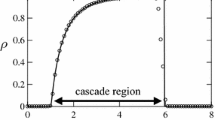Abstract
This paper analyzes the portfolio decision of an investor facing the threat of illiquidity. In a continuous-time setting, the efficiency loss due to illiquidity is addressed and quantified. For a logarithmic investor, we solve the portfolio problem explicitly. We show that the efficiency loss for a logarithmic investor with 30 years until the investment horizon is a significant 22.7% of current wealth if the illiquidity part of the model is calibrated to the Japanese data of the aftermath of WWII. For general utility functions, an explicit solution does not seem to be available. However, under a mild growth condition on the utility function, we show that the value function of a model in which only finitely many liquidity breakdowns can occur converges uniformly to the value function of a model with infinitely many breakdowns if the number of possible breakdowns goes to infinity. Furthermore, we show how the optimal security demands of the model with finitely many breakdowns can be used to approximate the solution of the model with infinitely many breakdowns. These results are illustrated for an investor with a power utility function.
Similar content being viewed by others
References
Bank, P., Baum, D.: Hedging and portfolio optimization in financial markets with a large trader. Math. Finance 14, 1–18 (2004)
Barro, R.J.: Rare disasters and asset markets in the twentieth century. Working Paper, Harvard University (2005). http://www.economics.harvard.edu/faculty/barro/
Çetin, U., Jarrow, R., Protter, P.: Liquidity risk and arbitrage pricing theory. Finance Stoch. 8, 311–341 (2004)
Davis, M.H.A., Norman, A.R.: Portfolio selection with transaction costs. Math. Oper. Res. 15, 676–713 (1990)
Duffie, D., Sun, T.-S.: Transactions costs and portfolio choice in a discrete-continuous time setting. J. Econ. Dyn. Control 14, 35–51 (1990)
Föllmer, H., Schweizer, M.: A microeconomic approach to diffusion models for stock prices. Math. Finance 3, 1–23 (1993)
Jorion, P., Goetzmann, W.N.: Global stock markets in the twentieth century. J. Finance 54, 953–980 (1999)
Kahl, M., Liu, J., Longstaff, F.A.: Paper millionaires: how valuable is stock to a stockholder who is restricted from selling it. J. Financ. Econ. 67, 385–410 (2003)
Korn, R.: Portfolio optimisation with strictly positive transaction costs and impulse control. Finance Stoch. 2, 85–114 (1998)
Longstaff, F.A.: Optimal portfolio choice and the valuation of illiquid securities. Rev. Financ. Stud. 14, 407–431 (2001)
Longstaff, F.A.: Asset pricing in markets with illiquid assets. Working Paper, UCLA, forthcoming in Am. Econ. Rev. (2005). http://www.anderson.ucla.edu/x1024.xml
Merton, R.C.: Lifetime portfolio selection under uncertainty: the continuous case. Rev. Econ. Stat. 51, 247–257 (1969)
Merton, R.C.: Optimal consumption and portfolio rules in a continuous-time model. J. Econ. Theory 3, 373–413 (1971)
Rietz, T.A.: The equity premium: a solution. J. Monet. Econ. 22, 117–131 (1988)
Rogers, L.C.G.: The relaxed investor and parameter uncertainty. Finance Stoch. 5, 131–154 (2001)
Schwartz, E.S., Tebaldi, C.: Illiquid assets and optimal portfolio choice. Working Paper, UCLA and NBER (2006). http://www.nber.org/papers/w12633
Siegel, J.J.: Stocks for the Long Run. McGraw-Hill, New York (2002)
Author information
Authors and Affiliations
Corresponding author
Rights and permissions
About this article
Cite this article
Diesinger, P., Kraft, H. & Seifried, F. Asset allocation and liquidity breakdowns: what if your broker does not answer the phone?. Finance Stoch 14, 343–374 (2010). https://doi.org/10.1007/s00780-008-0085-5
Received:
Accepted:
Published:
Issue Date:
DOI: https://doi.org/10.1007/s00780-008-0085-5



